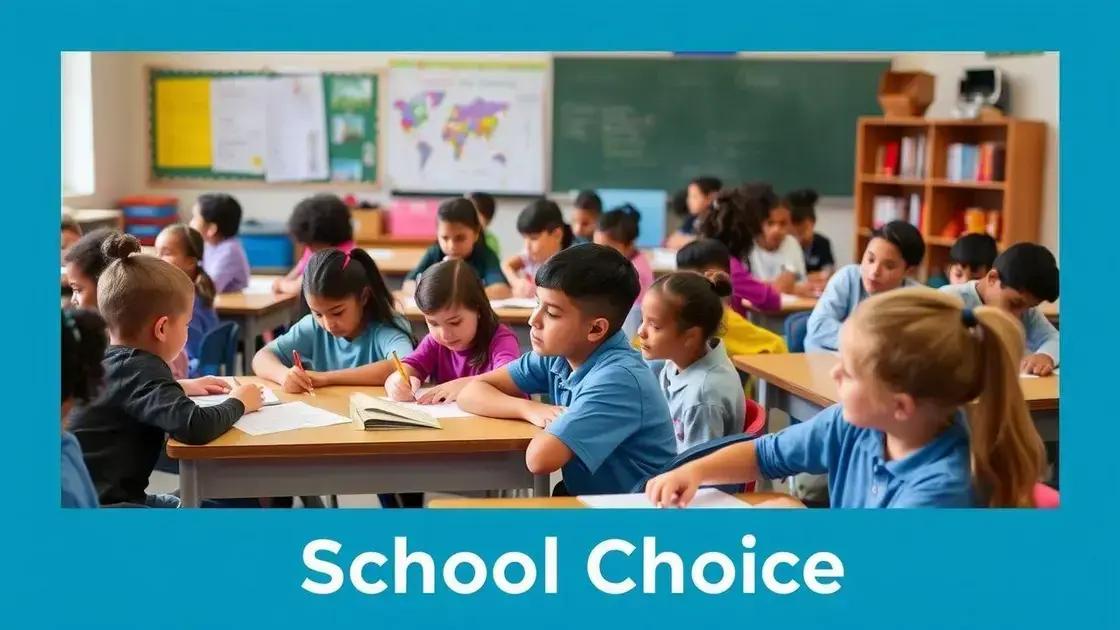School choice programs: unlocking new educational opportunities

Anúncios
School choice programs provide families with the option to select schools that best meet their children’s needs, enhancing personalized education and promoting student success.
School choice programs are reshaping education by giving families the power to select the best learning environments for their children. Have you ever wondered how these options can impact your child’s education?
Anúncios
Understanding school choice programs
Understanding school choice programs is essential for parents looking to enhance their children’s educational experience. These programs allow families to choose schools outside their assigned public school district, providing options that meet their child’s unique needs. Think about how this flexibility can change a child’s future.
Key Types of School Choice Programs
There are several types of school choice programs available. Each one offers different benefits and opportunities. Here are some of the most common types:
Anúncios
- Charter Schools: Publicly funded schools that operate independently from the traditional school system.
- Voucher Programs: Allow families to use public funding for private school tuition.
- Magnet Schools: Public schools with specialized curricula attracting students from various districts.
These programs aim to increase educational options and enhance student success. By understanding each system, parents can make informed decisions about their children’s education.
Benefits of School Choice Programs
School choice programs provide numerous advantages. Parents appreciate the ability to select schools that align with their values and teaching preferences. This choice can lead to satisfaction and community involvement. Additionally, students benefit from engaging in environments that match their learning styles.
Research indicates that when families have options, schools are motivated to improve. Competition encourages schools to maintain high standards, thus enriching the educational landscape. Opportunities for extracurricular activities and specialized programs also enhance the learning experience.
However, not everyone agrees on the effectiveness of these programs. Critics argue that school choice can divert funding from public schools. They fear that it may lead to increased inequality in the education system.
It’s important to weigh both the advantages and potential drawbacks before choosing a school for your child. Ultimately, the goal of school choice programs is to empower families and improve student outcomes by providing diverse educational opportunities.
Different types of school choice available
Exploring the different types of school choice available helps parents find the best fit for their children. Each type offers unique opportunities tailored to various educational needs. Below, we will break down the most common types of school choice programs.
Charter Schools
Charter schools are public schools that operate independently of the traditional school district system. They often emphasize specific educational philosophies or teaching methods, giving them the freedom to innovate. Charter schools can provide a personalized learning environment, which can be beneficial for students who thrive outside the conventional educational model.
Voucher Programs
Voucher programs allow parents to use public funding for private school tuition. This option gives families greater freedom to select schools that align with their values and educational goals. Vouchers can help lower-income families access quality private education that they may not have been able to afford otherwise.
Magnet Schools
Magnet schools are public schools that offer specialized programs or curricula, focusing on themes such as arts, science, or technology. These schools draw students from various districts, promoting diverse educational experiences. Magnet schools aim to provide unique learning opportunities that enhance student engagement and performance.
Home Schooling
Home schooling is another form of school choice where parents take responsibility for their child’s education at home. This approach allows for a highly personalized curriculum, catering to a child’s specific interests and strengths. Various resources and support groups exist to assist homeschooling families, making this option feasible for many.
Each type of school choice comes with its own set of regulations, advantages, and challenges. Understanding these differences is crucial for parents when making informed decisions about their children’s education. The right choice can have a lasting impact on a child’s academic success and personal growth.
Benefits of school choice for students

The benefits of school choice for students are significant and can greatly influence their educational journey. With various options available, children can find a learning environment that suits their individual needs, interests, and learning styles.
Personalized Learning
One major advantage is the opportunity for personalized learning. Students can select schools that offer specialized programs tailored to their strengths. This can lead to higher engagement and motivation, as they are learning in a way that resonates with them.
Increased Opportunities
School choice broadens educational horizons. Students have access to innovative curricula, extracurricular activities, and advanced placement programs that may not be available in their local public schools. These options can enhance their skills and prepare them for future challenges.
Parental Involvement
When parents are involved in choosing their child’s school, it fosters a sense of ownership and responsibility. This participation can strengthen the parent-child relationship and improve the overall educational experience. Parents who are engaged often support their children more effectively, which can lead to better academic performance.
- Diverse Learning Environments: Students can experience different teaching methods and educational philosophies.
- Social Skills Development: Interacting with peers from various backgrounds can enhance social skills and cultural awareness.
- Better Fit: Finding the right school helps reduce stress and anxiety, allowing students to thrive.
Research shows that students who participate in school choice programs often achieve higher test scores and have better graduation rates. These benefits contribute to long-term success and help students become well-rounded individuals. The power to choose schools fosters a competitive education system that encourages improvement across the board.
Challenges and criticisms of school choice
While school choice programs offer numerous benefits, they also come with challenges and criticisms that merit attention. Understanding these issues is essential for parents and policymakers as they navigate the educational landscape.
Equity Concerns
One significant criticism of school choice is its potential to widen the gap between different socioeconomic groups. Families with more resources can often take advantage of these programs, while those with fewer resources may struggle to access quality educational options. This situation can lead to a lack of equity in education, where marginalized communities have limited choices.
Impact on Public Schools
Another concern is how school choice programs affect public schools. Critics argue that transferring funds to private and charter schools diverts crucial resources away from traditional public schools. This can weaken the quality of education in public schools, causing a negative impact on the students who remain there.
Accountability Issues
Accountability is also a pressing issue. Unlike public schools, many charter and private schools are not held to the same standards. This difference can lead to varying educational quality and outcomes. Parents may not always know how schools measure up without adequate information to make informed decisions.
- Lack of Regulation: Some schools in choice programs operate with minimal oversight, affecting educational quality.
- Transportation Barriers: Accessing schools outside the local district can pose logistical challenges for families, particularly those without reliable transportation.
- Short-term Focus: Schools may prioritize immediate results over long-term student success due to enrollment competition.
As the debate over school choice continues, it is important to consider these challenges critically. Finding a balance between offering options and ensuring that all students receive a quality education remains a priority for many stakeholders within the community.
Real-life success stories and examples
Real-life success stories and examples of school choice programs highlight the positive impact these options can have on students and families. Many children have transformed their educational experiences by taking advantage of the flexibility school choice offers.
Case Study 1: Charter School Success
In a notable case, a charter school in Chicago has shown amazing results. This school focuses on STEM education and has increased student engagement significantly. The innovative teaching methods and smaller class sizes help students excel in subjects like math and science. As a result, the school’s students frequently score above average on standardized tests.
Case Study 2: Vouchers in Action
If we look at programs in Florida, voucher systems have helped many low-income families access high-quality private schools that cater to their students’ needs. Jane, a mother of two, used vouchers to enroll her children in a school with a strong arts program. Her children have flourished in this nurturing environment, showing improvements not only in their academics but also in their overall confidence.
Case Study 3: Magnet School Outcomes
In a diverse neighborhood of Houston, a magnet school focusing on the arts has become a beacon for students. It offers a curriculum enriched with music, theater, and visual arts. The school’s annual showcases feature students’ work, drawing community support and fostering pride. Graduates often go on to prestigious arts programs, illustrating the value of specialized education.
These examples demonstrate how school choice can lead to remarkable individual achievements. Schools that provide specialized programs based on students’ interests and strengths help them realize their potential. Through these stories, it’s clear that choosing the right educational path can shape a child’s future significantly.
In conclusion, school choice programs offer valuable options for families seeking the best education for their children. By providing diverse opportunities, these programs enhance personalized learning, foster engagement, and strengthen parent involvement. However, it is essential to consider the challenges and criticisms that accompany school choice. Understanding both the benefits and potential drawbacks can help families make informed decisions. Real-life success stories illustrate how effective these programs can be in helping students thrive academically and personally. Ultimately, the goal is to empower families and ensure that every child has access to quality education that meets their unique needs.
FAQ – Frequently Asked Questions about School Choice Programs
What are school choice programs?
School choice programs allow families to select educational options outside their assigned public schools, including charter schools, private schools, and magnet schools.
How do school choice programs benefit students?
These programs offer personalized learning environments, increased engagement, and access to specialized curricula, helping students thrive academically and personally.
What are some challenges associated with school choice programs?
Challenges include equity concerns, the impact on public school funding, and varying levels of accountability among different types of schools.
Can parents become involved in school choice?
Yes, parental involvement is key in school choice programs, as parents play an essential role in selecting the best school for their child’s educational needs.






